Military Telecommunications Project: Risk Response Plan Analysis
VerifiedAdded on 2022/09/17
|9
|1903
|20
Report
AI Summary
This report provides a detailed risk response plan for a project focused on upgrading telecommunications equipment within the US military's S6 information systems. It begins by defining the purpose of a risk response plan, the roles of a risk owner, and how project managers should assess and deal with risks. The report identifies common areas where risks can originate, such as customer ownership, regulatory compliance, and data integrity, and provides examples of specific risks within each area. It then outlines strategies for handling identified risks, including value chain propositions, regulatory adjustments, and fostering innovation. The report emphasizes the importance of security and privacy in this context and concludes by reiterating the need for proactive risk management in military telecommunications projects. References to relevant academic sources are included to support the analysis.

Running head: RISK RESPONSE PLAN
Risk Response Plan
Topic: Upgrading Telecommunications Equipment for Military S6 Information Systems
Name of the Student
Name of the University
Author Note
Risk Response Plan
Topic: Upgrading Telecommunications Equipment for Military S6 Information Systems
Name of the Student
Name of the University
Author Note
Paraphrase This Document
Need a fresh take? Get an instant paraphrase of this document with our AI Paraphraser
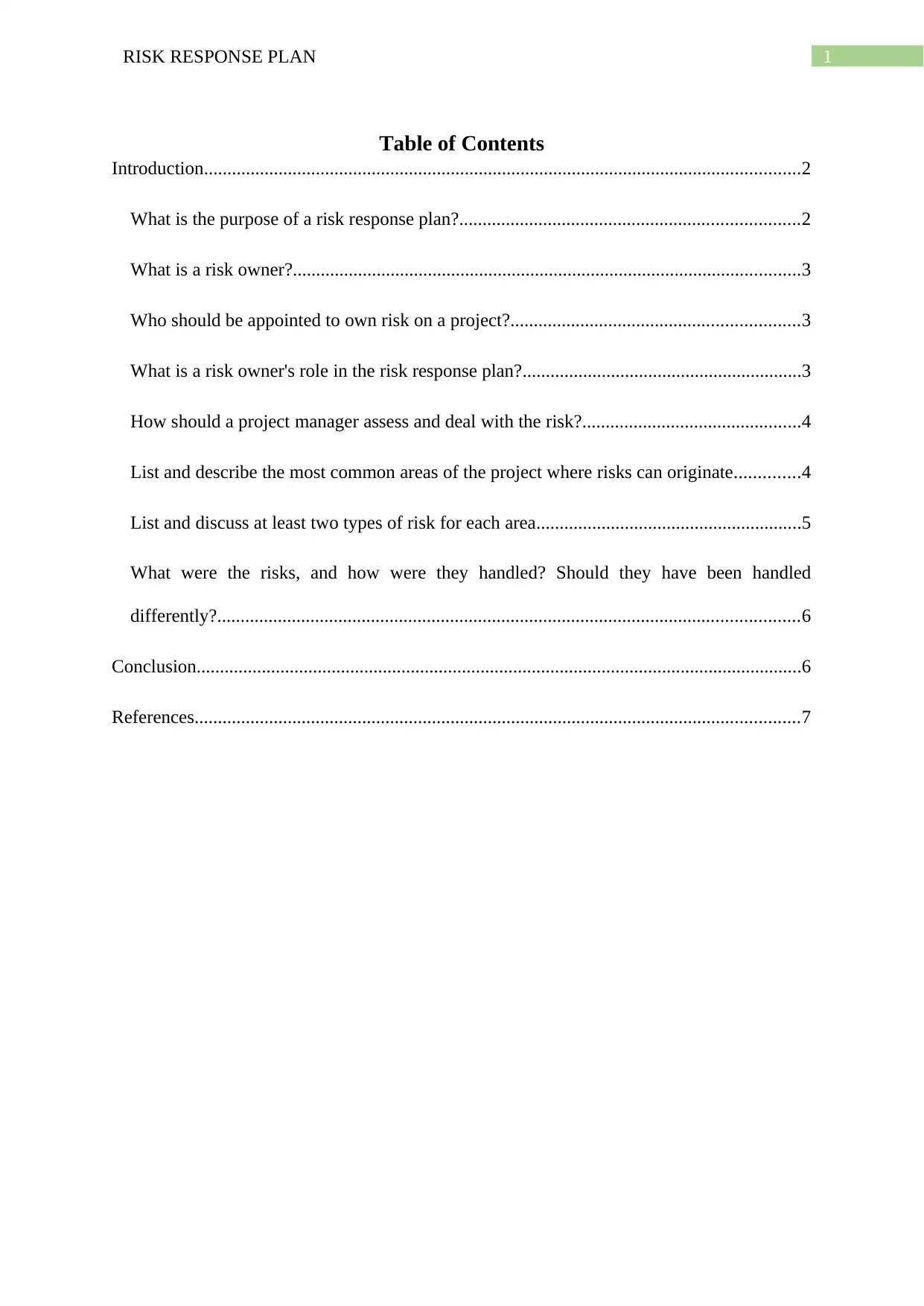
1RISK RESPONSE PLAN
Table of Contents
Introduction................................................................................................................................2
What is the purpose of a risk response plan?.........................................................................2
What is a risk owner?.............................................................................................................3
Who should be appointed to own risk on a project?..............................................................3
What is a risk owner's role in the risk response plan?............................................................3
How should a project manager assess and deal with the risk?...............................................4
List and describe the most common areas of the project where risks can originate..............4
List and discuss at least two types of risk for each area.........................................................5
What were the risks, and how were they handled? Should they have been handled
differently?.............................................................................................................................6
Conclusion..................................................................................................................................6
References..................................................................................................................................7
Table of Contents
Introduction................................................................................................................................2
What is the purpose of a risk response plan?.........................................................................2
What is a risk owner?.............................................................................................................3
Who should be appointed to own risk on a project?..............................................................3
What is a risk owner's role in the risk response plan?............................................................3
How should a project manager assess and deal with the risk?...............................................4
List and describe the most common areas of the project where risks can originate..............4
List and discuss at least two types of risk for each area.........................................................5
What were the risks, and how were they handled? Should they have been handled
differently?.............................................................................................................................6
Conclusion..................................................................................................................................6
References..................................................................................................................................7
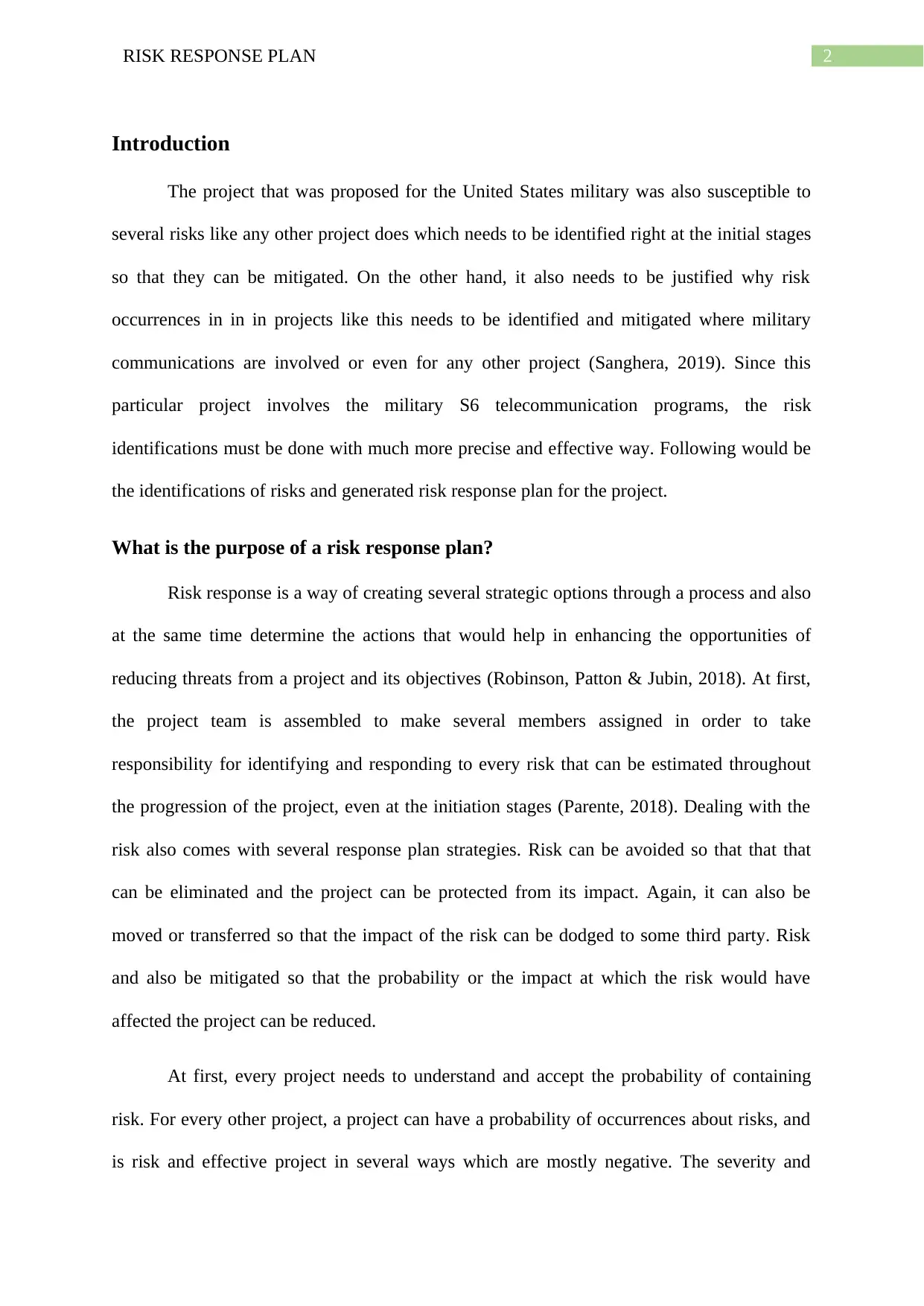
2RISK RESPONSE PLAN
Introduction
The project that was proposed for the United States military was also susceptible to
several risks like any other project does which needs to be identified right at the initial stages
so that they can be mitigated. On the other hand, it also needs to be justified why risk
occurrences in in in projects like this needs to be identified and mitigated where military
communications are involved or even for any other project (Sanghera, 2019). Since this
particular project involves the military S6 telecommunication programs, the risk
identifications must be done with much more precise and effective way. Following would be
the identifications of risks and generated risk response plan for the project.
What is the purpose of a risk response plan?
Risk response is a way of creating several strategic options through a process and also
at the same time determine the actions that would help in enhancing the opportunities of
reducing threats from a project and its objectives (Robinson, Patton & Jubin, 2018). At first,
the project team is assembled to make several members assigned in order to take
responsibility for identifying and responding to every risk that can be estimated throughout
the progression of the project, even at the initiation stages (Parente, 2018). Dealing with the
risk also comes with several response plan strategies. Risk can be avoided so that that that
can be eliminated and the project can be protected from its impact. Again, it can also be
moved or transferred so that the impact of the risk can be dodged to some third party. Risk
and also be mitigated so that the probability or the impact at which the risk would have
affected the project can be reduced.
At first, every project needs to understand and accept the probability of containing
risk. For every other project, a project can have a probability of occurrences about risks, and
is risk and effective project in several ways which are mostly negative. The severity and
Introduction
The project that was proposed for the United States military was also susceptible to
several risks like any other project does which needs to be identified right at the initial stages
so that they can be mitigated. On the other hand, it also needs to be justified why risk
occurrences in in in projects like this needs to be identified and mitigated where military
communications are involved or even for any other project (Sanghera, 2019). Since this
particular project involves the military S6 telecommunication programs, the risk
identifications must be done with much more precise and effective way. Following would be
the identifications of risks and generated risk response plan for the project.
What is the purpose of a risk response plan?
Risk response is a way of creating several strategic options through a process and also
at the same time determine the actions that would help in enhancing the opportunities of
reducing threats from a project and its objectives (Robinson, Patton & Jubin, 2018). At first,
the project team is assembled to make several members assigned in order to take
responsibility for identifying and responding to every risk that can be estimated throughout
the progression of the project, even at the initiation stages (Parente, 2018). Dealing with the
risk also comes with several response plan strategies. Risk can be avoided so that that that
can be eliminated and the project can be protected from its impact. Again, it can also be
moved or transferred so that the impact of the risk can be dodged to some third party. Risk
and also be mitigated so that the probability or the impact at which the risk would have
affected the project can be reduced.
At first, every project needs to understand and accept the probability of containing
risk. For every other project, a project can have a probability of occurrences about risks, and
is risk and effective project in several ways which are mostly negative. The severity and
⊘ This is a preview!⊘
Do you want full access?
Subscribe today to unlock all pages.

Trusted by 1+ million students worldwide
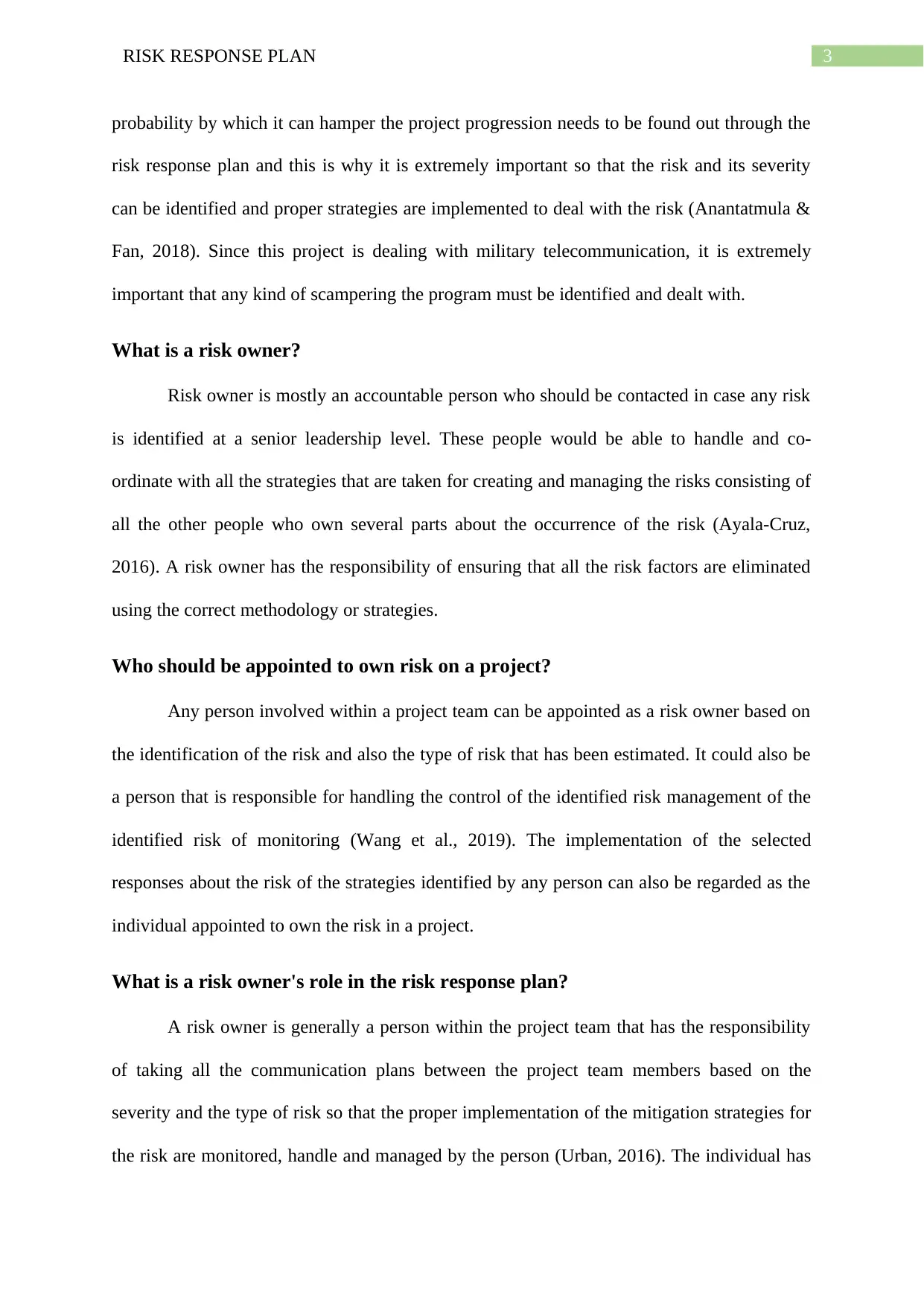
3RISK RESPONSE PLAN
probability by which it can hamper the project progression needs to be found out through the
risk response plan and this is why it is extremely important so that the risk and its severity
can be identified and proper strategies are implemented to deal with the risk (Anantatmula &
Fan, 2018). Since this project is dealing with military telecommunication, it is extremely
important that any kind of scampering the program must be identified and dealt with.
What is a risk owner?
Risk owner is mostly an accountable person who should be contacted in case any risk
is identified at a senior leadership level. These people would be able to handle and co-
ordinate with all the strategies that are taken for creating and managing the risks consisting of
all the other people who own several parts about the occurrence of the risk (Ayala-Cruz,
2016). A risk owner has the responsibility of ensuring that all the risk factors are eliminated
using the correct methodology or strategies.
Who should be appointed to own risk on a project?
Any person involved within a project team can be appointed as a risk owner based on
the identification of the risk and also the type of risk that has been estimated. It could also be
a person that is responsible for handling the control of the identified risk management of the
identified risk of monitoring (Wang et al., 2019). The implementation of the selected
responses about the risk of the strategies identified by any person can also be regarded as the
individual appointed to own the risk in a project.
What is a risk owner's role in the risk response plan?
A risk owner is generally a person within the project team that has the responsibility
of taking all the communication plans between the project team members based on the
severity and the type of risk so that the proper implementation of the mitigation strategies for
the risk are monitored, handle and managed by the person (Urban, 2016). The individual has
probability by which it can hamper the project progression needs to be found out through the
risk response plan and this is why it is extremely important so that the risk and its severity
can be identified and proper strategies are implemented to deal with the risk (Anantatmula &
Fan, 2018). Since this project is dealing with military telecommunication, it is extremely
important that any kind of scampering the program must be identified and dealt with.
What is a risk owner?
Risk owner is mostly an accountable person who should be contacted in case any risk
is identified at a senior leadership level. These people would be able to handle and co-
ordinate with all the strategies that are taken for creating and managing the risks consisting of
all the other people who own several parts about the occurrence of the risk (Ayala-Cruz,
2016). A risk owner has the responsibility of ensuring that all the risk factors are eliminated
using the correct methodology or strategies.
Who should be appointed to own risk on a project?
Any person involved within a project team can be appointed as a risk owner based on
the identification of the risk and also the type of risk that has been estimated. It could also be
a person that is responsible for handling the control of the identified risk management of the
identified risk of monitoring (Wang et al., 2019). The implementation of the selected
responses about the risk of the strategies identified by any person can also be regarded as the
individual appointed to own the risk in a project.
What is a risk owner's role in the risk response plan?
A risk owner is generally a person within the project team that has the responsibility
of taking all the communication plans between the project team members based on the
severity and the type of risk so that the proper implementation of the mitigation strategies for
the risk are monitored, handle and managed by the person (Urban, 2016). The individual has
Paraphrase This Document
Need a fresh take? Get an instant paraphrase of this document with our AI Paraphraser
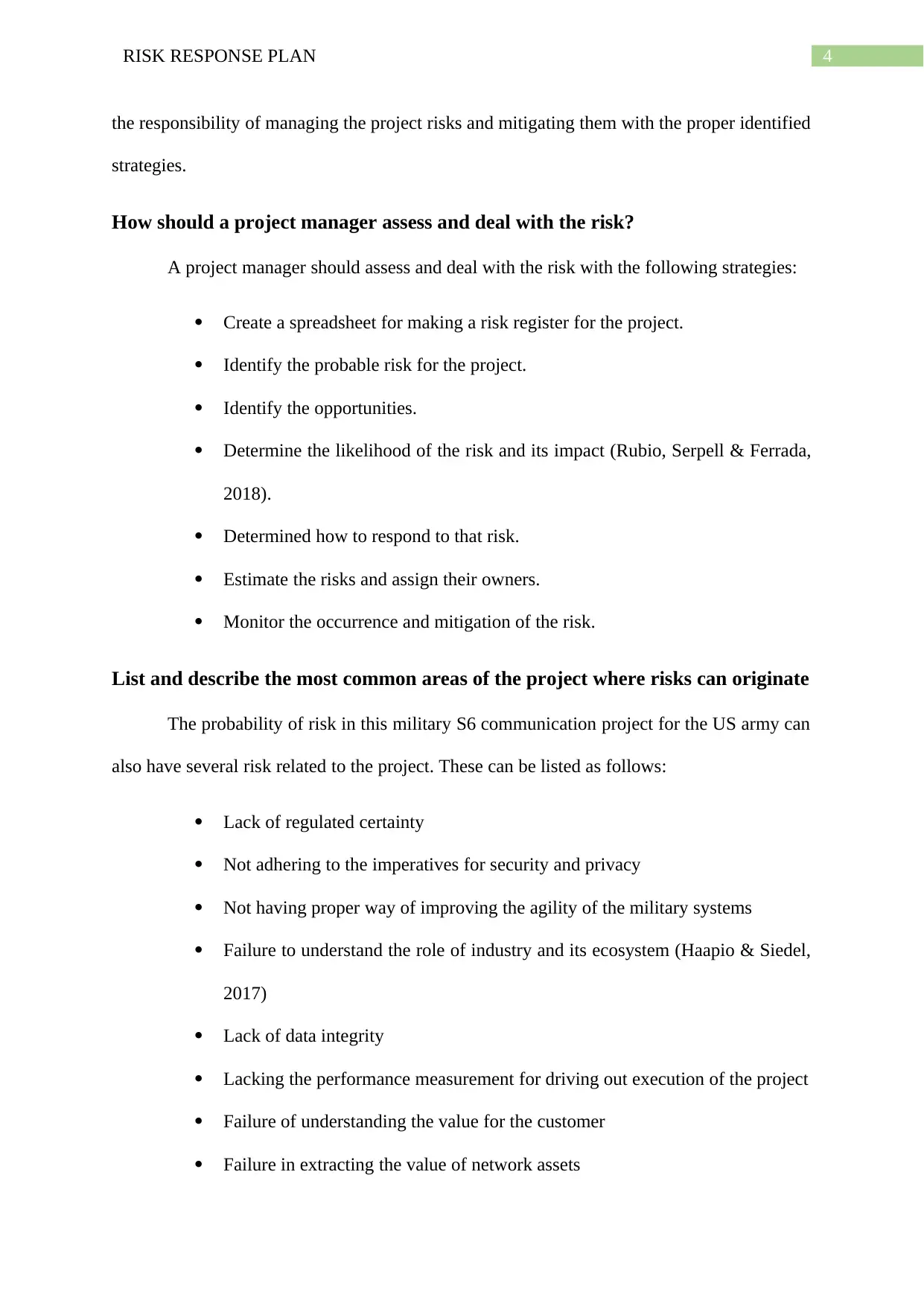
4RISK RESPONSE PLAN
the responsibility of managing the project risks and mitigating them with the proper identified
strategies.
How should a project manager assess and deal with the risk?
A project manager should assess and deal with the risk with the following strategies:
Create a spreadsheet for making a risk register for the project.
Identify the probable risk for the project.
Identify the opportunities.
Determine the likelihood of the risk and its impact (Rubio, Serpell & Ferrada,
2018).
Determined how to respond to that risk.
Estimate the risks and assign their owners.
Monitor the occurrence and mitigation of the risk.
List and describe the most common areas of the project where risks can originate
The probability of risk in this military S6 communication project for the US army can
also have several risk related to the project. These can be listed as follows:
Lack of regulated certainty
Not adhering to the imperatives for security and privacy
Not having proper way of improving the agility of the military systems
Failure to understand the role of industry and its ecosystem (Haapio & Siedel,
2017)
Lack of data integrity
Lacking the performance measurement for driving out execution of the project
Failure of understanding the value for the customer
Failure in extracting the value of network assets
the responsibility of managing the project risks and mitigating them with the proper identified
strategies.
How should a project manager assess and deal with the risk?
A project manager should assess and deal with the risk with the following strategies:
Create a spreadsheet for making a risk register for the project.
Identify the probable risk for the project.
Identify the opportunities.
Determine the likelihood of the risk and its impact (Rubio, Serpell & Ferrada,
2018).
Determined how to respond to that risk.
Estimate the risks and assign their owners.
Monitor the occurrence and mitigation of the risk.
List and describe the most common areas of the project where risks can originate
The probability of risk in this military S6 communication project for the US army can
also have several risk related to the project. These can be listed as follows:
Lack of regulated certainty
Not adhering to the imperatives for security and privacy
Not having proper way of improving the agility of the military systems
Failure to understand the role of industry and its ecosystem (Haapio & Siedel,
2017)
Lack of data integrity
Lacking the performance measurement for driving out execution of the project
Failure of understanding the value for the customer
Failure in extracting the value of network assets
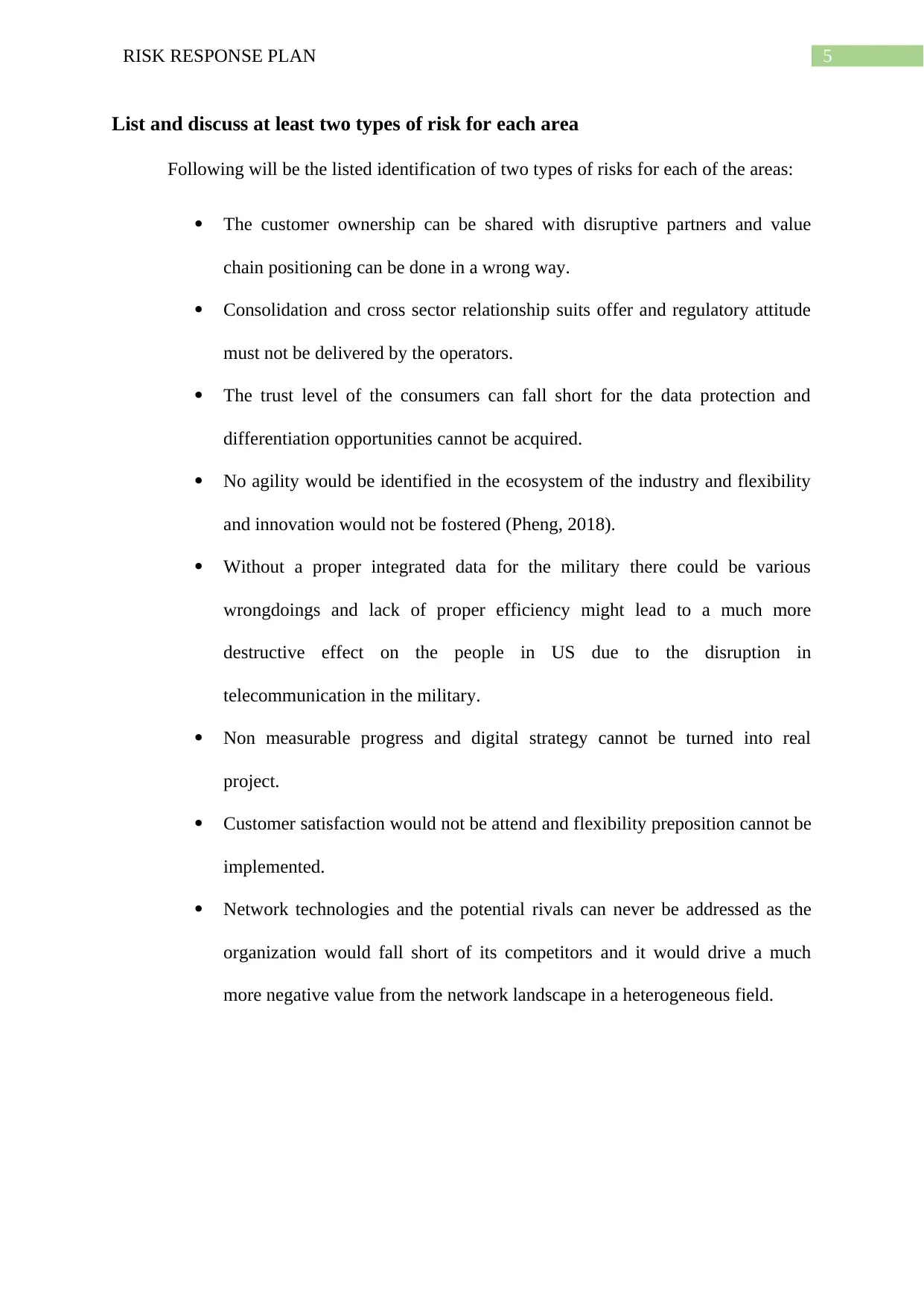
5RISK RESPONSE PLAN
List and discuss at least two types of risk for each area
Following will be the listed identification of two types of risks for each of the areas:
The customer ownership can be shared with disruptive partners and value
chain positioning can be done in a wrong way.
Consolidation and cross sector relationship suits offer and regulatory attitude
must not be delivered by the operators.
The trust level of the consumers can fall short for the data protection and
differentiation opportunities cannot be acquired.
No agility would be identified in the ecosystem of the industry and flexibility
and innovation would not be fostered (Pheng, 2018).
Without a proper integrated data for the military there could be various
wrongdoings and lack of proper efficiency might lead to a much more
destructive effect on the people in US due to the disruption in
telecommunication in the military.
Non measurable progress and digital strategy cannot be turned into real
project.
Customer satisfaction would not be attend and flexibility preposition cannot be
implemented.
Network technologies and the potential rivals can never be addressed as the
organization would fall short of its competitors and it would drive a much
more negative value from the network landscape in a heterogeneous field.
List and discuss at least two types of risk for each area
Following will be the listed identification of two types of risks for each of the areas:
The customer ownership can be shared with disruptive partners and value
chain positioning can be done in a wrong way.
Consolidation and cross sector relationship suits offer and regulatory attitude
must not be delivered by the operators.
The trust level of the consumers can fall short for the data protection and
differentiation opportunities cannot be acquired.
No agility would be identified in the ecosystem of the industry and flexibility
and innovation would not be fostered (Pheng, 2018).
Without a proper integrated data for the military there could be various
wrongdoings and lack of proper efficiency might lead to a much more
destructive effect on the people in US due to the disruption in
telecommunication in the military.
Non measurable progress and digital strategy cannot be turned into real
project.
Customer satisfaction would not be attend and flexibility preposition cannot be
implemented.
Network technologies and the potential rivals can never be addressed as the
organization would fall short of its competitors and it would drive a much
more negative value from the network landscape in a heterogeneous field.
⊘ This is a preview!⊘
Do you want full access?
Subscribe today to unlock all pages.

Trusted by 1+ million students worldwide
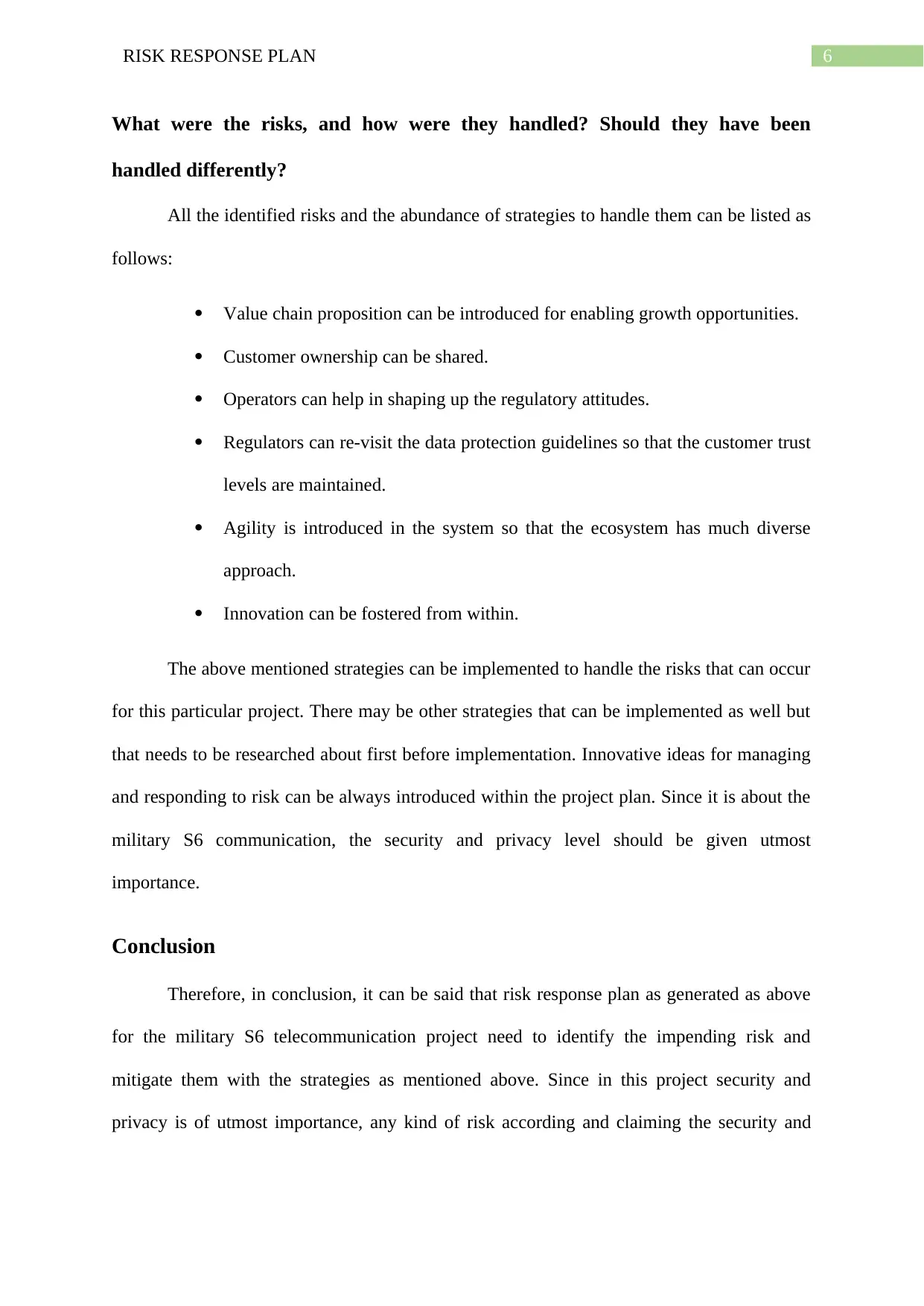
6RISK RESPONSE PLAN
What were the risks, and how were they handled? Should they have been
handled differently?
All the identified risks and the abundance of strategies to handle them can be listed as
follows:
Value chain proposition can be introduced for enabling growth opportunities.
Customer ownership can be shared.
Operators can help in shaping up the regulatory attitudes.
Regulators can re-visit the data protection guidelines so that the customer trust
levels are maintained.
Agility is introduced in the system so that the ecosystem has much diverse
approach.
Innovation can be fostered from within.
The above mentioned strategies can be implemented to handle the risks that can occur
for this particular project. There may be other strategies that can be implemented as well but
that needs to be researched about first before implementation. Innovative ideas for managing
and responding to risk can be always introduced within the project plan. Since it is about the
military S6 communication, the security and privacy level should be given utmost
importance.
Conclusion
Therefore, in conclusion, it can be said that risk response plan as generated as above
for the military S6 telecommunication project need to identify the impending risk and
mitigate them with the strategies as mentioned above. Since in this project security and
privacy is of utmost importance, any kind of risk according and claiming the security and
What were the risks, and how were they handled? Should they have been
handled differently?
All the identified risks and the abundance of strategies to handle them can be listed as
follows:
Value chain proposition can be introduced for enabling growth opportunities.
Customer ownership can be shared.
Operators can help in shaping up the regulatory attitudes.
Regulators can re-visit the data protection guidelines so that the customer trust
levels are maintained.
Agility is introduced in the system so that the ecosystem has much diverse
approach.
Innovation can be fostered from within.
The above mentioned strategies can be implemented to handle the risks that can occur
for this particular project. There may be other strategies that can be implemented as well but
that needs to be researched about first before implementation. Innovative ideas for managing
and responding to risk can be always introduced within the project plan. Since it is about the
military S6 communication, the security and privacy level should be given utmost
importance.
Conclusion
Therefore, in conclusion, it can be said that risk response plan as generated as above
for the military S6 telecommunication project need to identify the impending risk and
mitigate them with the strategies as mentioned above. Since in this project security and
privacy is of utmost importance, any kind of risk according and claiming the security and
Paraphrase This Document
Need a fresh take? Get an instant paraphrase of this document with our AI Paraphraser

7RISK RESPONSE PLAN
privacy measures should be mitigated at the first place. The strategies and the risk mitigation
plans have been described in details as above.
privacy measures should be mitigated at the first place. The strategies and the risk mitigation
plans have been described in details as above.
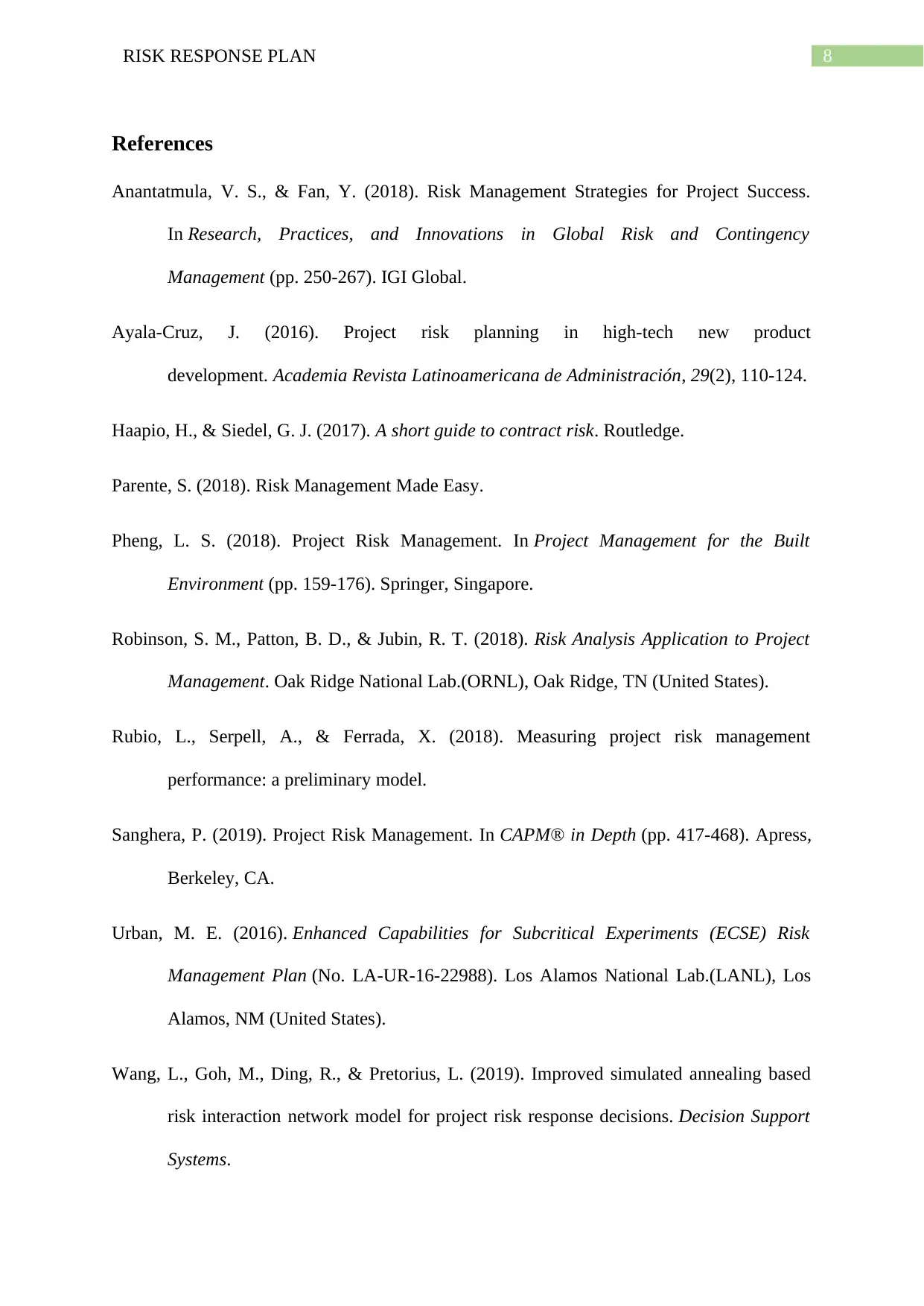
8RISK RESPONSE PLAN
References
Anantatmula, V. S., & Fan, Y. (2018). Risk Management Strategies for Project Success.
In Research, Practices, and Innovations in Global Risk and Contingency
Management (pp. 250-267). IGI Global.
Ayala-Cruz, J. (2016). Project risk planning in high-tech new product
development. Academia Revista Latinoamericana de Administración, 29(2), 110-124.
Haapio, H., & Siedel, G. J. (2017). A short guide to contract risk. Routledge.
Parente, S. (2018). Risk Management Made Easy.
Pheng, L. S. (2018). Project Risk Management. In Project Management for the Built
Environment (pp. 159-176). Springer, Singapore.
Robinson, S. M., Patton, B. D., & Jubin, R. T. (2018). Risk Analysis Application to Project
Management. Oak Ridge National Lab.(ORNL), Oak Ridge, TN (United States).
Rubio, L., Serpell, A., & Ferrada, X. (2018). Measuring project risk management
performance: a preliminary model.
Sanghera, P. (2019). Project Risk Management. In CAPM® in Depth (pp. 417-468). Apress,
Berkeley, CA.
Urban, M. E. (2016). Enhanced Capabilities for Subcritical Experiments (ECSE) Risk
Management Plan (No. LA-UR-16-22988). Los Alamos National Lab.(LANL), Los
Alamos, NM (United States).
Wang, L., Goh, M., Ding, R., & Pretorius, L. (2019). Improved simulated annealing based
risk interaction network model for project risk response decisions. Decision Support
Systems.
References
Anantatmula, V. S., & Fan, Y. (2018). Risk Management Strategies for Project Success.
In Research, Practices, and Innovations in Global Risk and Contingency
Management (pp. 250-267). IGI Global.
Ayala-Cruz, J. (2016). Project risk planning in high-tech new product
development. Academia Revista Latinoamericana de Administración, 29(2), 110-124.
Haapio, H., & Siedel, G. J. (2017). A short guide to contract risk. Routledge.
Parente, S. (2018). Risk Management Made Easy.
Pheng, L. S. (2018). Project Risk Management. In Project Management for the Built
Environment (pp. 159-176). Springer, Singapore.
Robinson, S. M., Patton, B. D., & Jubin, R. T. (2018). Risk Analysis Application to Project
Management. Oak Ridge National Lab.(ORNL), Oak Ridge, TN (United States).
Rubio, L., Serpell, A., & Ferrada, X. (2018). Measuring project risk management
performance: a preliminary model.
Sanghera, P. (2019). Project Risk Management. In CAPM® in Depth (pp. 417-468). Apress,
Berkeley, CA.
Urban, M. E. (2016). Enhanced Capabilities for Subcritical Experiments (ECSE) Risk
Management Plan (No. LA-UR-16-22988). Los Alamos National Lab.(LANL), Los
Alamos, NM (United States).
Wang, L., Goh, M., Ding, R., & Pretorius, L. (2019). Improved simulated annealing based
risk interaction network model for project risk response decisions. Decision Support
Systems.
⊘ This is a preview!⊘
Do you want full access?
Subscribe today to unlock all pages.

Trusted by 1+ million students worldwide
1 out of 9
Related Documents
Your All-in-One AI-Powered Toolkit for Academic Success.
+13062052269
info@desklib.com
Available 24*7 on WhatsApp / Email
![[object Object]](/_next/static/media/star-bottom.7253800d.svg)
Unlock your academic potential
Copyright © 2020–2025 A2Z Services. All Rights Reserved. Developed and managed by ZUCOL.




